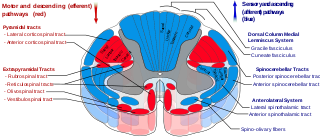Extrapyramidal can refer to:
| This disambiguation page lists articles associated with the title Extrapyramidal. If an internal link led you here, you may wish to change the link to point directly to the intended article. |
Extrapyramidal can refer to:
| This disambiguation page lists articles associated with the title Extrapyramidal. If an internal link led you here, you may wish to change the link to point directly to the intended article. |

Haloperidol, marketed under the trade name Haldol among others, is a typical antipsychotic medication. Haloperidol is used in the treatment of schizophrenia, tics in Tourette syndrome, mania in bipolar disorder, nausea and vomiting, delirium, agitation, acute psychosis, and hallucinations in alcohol withdrawal. It may be used by mouth or injection into a muscle or a vein. Haloperidol typically works within thirty to sixty minutes. A long-acting formulation may be used as an injection every four weeks in people with schizophrenia or related illnesses, who either forget or refuse to take the medication by mouth.

Benzatropine, also spelled benztropine, is a medication used to treat a type of movement disorder due to antipsychotics known as dystonia and parkinsonism. It is not useful for tardive dyskinesia. It is taken by mouth or by injection into a vein or muscle. Benefits are seen within two hours and last for up to ten hours.
The motor system is the set of central and peripheral structures in the nervous system that support motor functions, i.e. movement. Peripheral structures may include skeletal muscles and neural connections with muscle tissues. Central structures include cerebral cortex, brainstem, spinal cord, pyramidal system including the upper motor neurons, extrapyramidal system, cerebellum, and the lower motor neurons in the brainstem and the spinal cord.

Perphenazine is a typical antipsychotic drug. Chemically, it is classified as a piperazinyl phenothiazine. Originally marketed in the US as Trilafon, it has been in clinical use for decades.

Loxapine is a typical antipsychotic medication used primarily in the treatment of schizophrenia. The drug is a member of the dibenzoxazepine class and structurally related to clozapine. Several researchers have argued that loxapine may behave as an atypical antipsychotic.

In anatomy, the extrapyramidal system is a part of the motor system network causing involuntary actions. The system is called extrapyramidal to distinguish it from the tracts of the motor cortex that reach their targets by traveling through the pyramids of the medulla. The pyramidal tracts may directly innervate motor neurons of the spinal cord or brainstem, whereas the extrapyramidal system centers on the modulation and regulation of anterior (ventral) horn cells.

In humans, the tectospinal tract is a nerve tract that coordinates head and eye movements. This tract is part of the extrapyramidal system and connects the midbrain tectum, and cervical regions of the spinal cord.

Progabide is an analogue and prodrug of γ-aminobutyric acid (GABA) used in the treatment of epilepsy. Via conversion into GABA, progabide behaves as an agonist of the GABAA, GABAB, and GABAA-ρ receptors.

Chlorprothixene, sold under the brand name Truxal among others, is a typical antipsychotic of the thioxanthene group.

The vestibulospinal tract is a neural tract in the central nervous system. Specifically, it is a component of the extrapyramidal system and is classified as a component of the medial pathway. Like other descending motor pathways, the vestibulospinal fibers of the tract relay information from nuclei to motor neurons. The vestibular nuclei receive information through the vestibulocochlear nerve about changes in the orientation of the head. The nuclei relay motor commands through the vestibulospinal tract. The function of these motor commands is to alter muscle tone, extend, and change the position of the limbs and head with the goal of supporting posture and maintaining balance of the body and head.

Profenamine is a phenothiazine derivative used as an antiparkinsonian agent that has anticholinergic, antihistamine, and antiadrenergic actions. It is also used in the alleviation of the extrapyramidal syndrome induced by drugs such as other phenothiazine compounds, but, like other compounds with antimuscarinic properties, is of no value against tardive dyskinesia.
Extrapyramidal symptoms (EPS), also known as extrapyramidal side effects (EPSE) if drug-induced, are movement disorders, which include acute and long term symptoms. These symptoms include dystonia, akathisia, parkinsonism, bradykinesia, tremor, and tardive dyskinesia. Antipsychotics are often discontinued due to inefficacy and intolerable side effects such as extrapyramidal symptoms.

Propiomazine is an antihistamine blocking H1 receptors. It is used to treat insomnia, and to produce sleepiness or drowsiness and to relieve anxiety before or during surgery or other procedures and in combination with analgetics also during labor. Propiomazine is a phenothiazine, but is not used as a neuroleptic because it does not block dopamine receptors well.

Promazine is a medication that belongs to the phenothiazine class of antipsychotics. An older medication used to treat schizophrenia, it is still prescribed, alongside newer agents such as olanzapine and quetiapine. It has predominantly anticholinergic side effects, though extrapyramidal side effects are not uncommon either.

Dexetimide is a piperidine anticholinergic. It is a muscarinic antagonist that is used to treat drug induced parkinsonism. Dexetimide was discovered at Janssen Pharmaceutica in 1968.

Trifluperidol is a typical antipsychotic of the butyrophenone chemical class. It has general properties similar to those of haloperidol, but is considerably more potent by weight, and causes relatively more severe side effects, especially tardive dyskinesia and other extrapyramidal effects. It is used in the treatment of psychoses including mania and schizophrenia. It was discovered at Janssen Pharmaceutica in 1959.

Clebopride is a dopamine antagonist drug with antiemetic and prokinetic properties used to treat functional gastrointestinal disorders. Chemically, it is a substituted benzamide, closely related to metoclopramide.

Perospirone (Lullan) is an atypical antipsychotic of the azapirone family. It was introduced in Japan by Dainippon Sumitomo Pharma in 2001 for the treatment of schizophrenia and acute cases of bipolar mania.

Clotiapine (Entumine) is an atypical antipsychotic of the dibenzothiazepine chemical class. It was first introduced in a few European countries, Argentina, Taiwan and Israel in 1970.

BRL-44408 is a drug used in scientific research which acts as a selective antagonist for the α2A adrenoreceptor. It has been suggested as having potential therapeutic application in the treatment of extrapyramidal side effects produced by some antipsychotic medications.